|
|
Persimmon

|
|
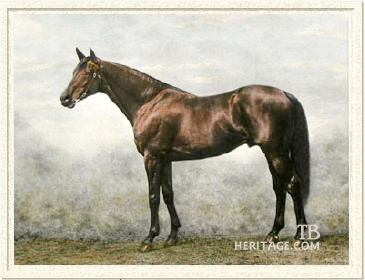 |
|
|
Probably no member of Britain's royal family has had the spectacular racing success of Albert Edward, Prince of Wales, afterward, King Edward VII, whose stud was located at Sandringham in Norfolk. He bred and raced the great trio of brothers from Perdita II -- classic winners Persimmon and Diamond Jubilee, and stakes winner Florizel II -- and his third Derby winner, Minoru, he leased from Colonel Hall Walker to run in the royal colors.
Persimmon was a lovely bay colt with a highly-charged nervous disposition, a characteristic of the St. Simon progeny. He was highly thought of from the beginning, and was brought along patiently by trainer Richard Marsh, who succeeded Porter as the royal trainer.
As a juvenile, Persimmon raced only three times. He made his debut at Royal Ascot in the Coventry Stakes, and won easily. The Richmond Stakes at Goodwood fell to Persimmon next, and then he was sent after the premier race for young thoroughbreds in England, the Middle Park Plate. Plagued by a cough, Persimmon was not pushed and finished a weary third to another St. Simon son, St. Frusquin, racing for Leopold de Rothschild. St. Frusquin was a brilliant colt in his own right, and he and Persimmon would be rivals on the track and in the breeding shed in the following years.
The classic season for these two brilliant colts was one of the finest in many years. St. Frusquin easily scored in the Two Thousand Guineas, Persimmon a bit backward that early in the spring, and still training towards the ultimate classic race--the Derby at Epsom. He very nearly did not make it there:
"It was planned for Persimmon to travel by train from Dullingham Station to Epsom. Usually, he was a tractable, easygoing traveler but on this all-important occasion, he took it into his head to be awkward and stubbornly refused to enter his box. The situation was verging on desperate when two horse specials had left Dullingham without him and with only fifteen minutes left before the final one departed, he showed not the slightest sign of changing his mind. Marsh, distraught with worry and on the brink of apoplexy, then played his last card. He enlisted a dozen lusty volunteers and between them they more or less carried Persimmon into his box. Once inside, Persimmon realized the game was over and settled down quietly to enjoy his feed." (Mortimer and Willett, Great Racehorses of the World)
The Derby was expected to be a battle between Persimmon and St. Frusquin, and it was. They locked horns with about furlong to go, and both drove for the finish. St. Frusquin had the advantage, but Persimmon, with Jack Watts up, relentlessly kept coming. Even a little bobble near the wire did not deter the royal colorbearer, as he surged forward to beat his rival by a hard-earned neck. Persimmon's victory was wildly popular, and Epsom Downs erupted as the Prince of Wales led in his champion.
Persimmon and St. Frusquin met again at Royal Ascot, in the Princess of Wales Stakes, and the crowd was treated to another thrilling duel between these two superb colts. St. Frusquin carried three less pounds than Persimmon, but the race was still close, as St. Frusquin prevailed by half a length. They never met again on the track. St. Frusquin went on to win the Eclipse Stakes, but his suspensory ligaments in both front legs gave way while training for the last classic, the St. Leger, and he was retired to stud. Persimmon was rested until that autumn classic, which he easily won. St. Frusquin had taken his measure two out of three times, but they were clearly almost identical in talent.
Persimmon had one more race as a three-year-old--the Jockey Club Stakes at Newmarket. He won impressively from a fine field, including Sir Visto, winner of the Derby the year before.
Persimmon only had two races as a four-year-old, but he won both and did so in such a fashion as to seal his reputation as a great racehorse, as he won both at a distance, in the Ascot Gold Cup, and in the speed event, the Eclipse Stakes, carrying the high weight of 142 pounds in the latter.
The Ascot Gold Cup, over 2-1/2 miles, Persimmon won by eight lengths from a decent field which included Winkfield's Pride, a sharp handicap performer. The Eclipse Stakes was run at Sandown in July, at half the distance of the Gold Cup. The Prince's colt had been worked carefully to hone his speed. His main competition was Bay Ronald and Velasquez. Beato was the outsider in the field of five, but only Velasquez was considered to have a realistic chance of upsetting the favorite.
Velasquez was a formidable competitor. The Earl of Rosebery's son of Donovan was beautifully bred--his dam, Vista had previously produced Two Thousand Guineas winner Bona Vista, and Derby winner Sir Visto, conquered by Persimmon the previous autumn at Newmarket. Valesquez was also a very talented racer. Prior to the Eclipse, he had run second to Galtee More in the Two Thousand Guineas and the Derby and had captured the Princess of Wales Stakes just before running against Persimmon in the Eclipse.
Persimmon struggled early on the rock-hard turf, but when he got going, he passed Valesquez and won by two and a half lengths. It was not his most brilliant performance, but he overcame a surface he did not like and won in convincing fashion. Valesquez went on to win the Champion Stakes later that season, and got his own Eclipse Stakes victory the next year, as well as a second Champion Stakes, thus making Persimmon's victory over him all the more impressive.
Persimmon's Ascot Gold Cup and Eclipse sweep came with a price. The hard turf in both races led to career-ending injuries in his hocks, and he was retired from the track. Sent to the stallion paddocks of Sandringham, his stud fee was set at 300 guineas.
|
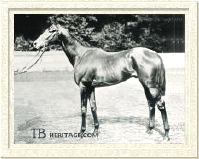
Persimmon at age 3 | |
| Persimmon's Race Record |
| Year | Age | Starts | 1st | 2nd | 3rd |
| 1895 | 2 | 3 | 2 | 0 | 1 |
| 1896 | 3 | 4 | 3 | 1 | 0 |
| 1897 | 4 | 2 | 2 | 0 | 0 |
| Total | -- | 9 | 7 | 1 | 1 |
|
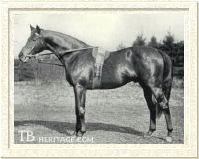
Persimmon at stud | | Persimmon in the Stud
Between them, the St. Simon sons Persimmon and his old turf rival, St. Frusqin, were responsible for eleven winners of fourteen classic races. Persimmon was a champion sire on four occasions and champion broodmare sire twice. St. Frusqin was champion sire twice, and champion broodmare sire once.
Persimmon's most outstanding offspring was undoubtedly the brilliant filly, SCEPTRE, victress in 1902 of every classic race except the Derby. Persimmon's other classic champions were: Keystone II, winner of the Oaks and Coronation Stakes; Your Majesty, winner of the St. Leger; Perola, winner of the Oaks; and PRINCE PALATINE, winner of the St. Leger.
|
In 1906 Persimmon's daughter Keystone II took the Oaks, and the St. Frusquin filly, Flair, won the One Thousand Guineas. Two years later, Your Majesty took the St. Leger, and St. Frusquin's daughter, Rhodora, took the One Thousand Guineas.
Prince Palatine was Persimmon's best colt, for he captured during his career such important events as the Ascot Gold Cup, which he won twice, the Coronation Cup, the Eclipse Stakes, the Doncaster Cup, and the Jockey Club Stakes. Standing at stud successively in England, France, and the United States, Prince Palatine was widely considered a failure as a stallion, but through his son, Rose Prince, he founded a male line that culminated with Round Table, a multiple champion in North America and one-time leading money earner of the world. Prince Palatine's daughter, Blue Glass, was the dam of Unbreakable, ancestor in the male line of Native Dancer, Mr. Prospector, and Alydar. |
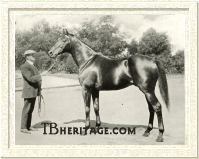
Your Majesty
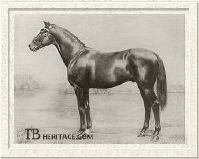
Zinfandel
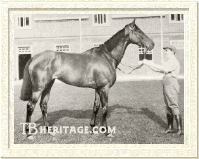
Keystone II
| |
YOUR MAJESTY (out of the Italian mare Yours, by Melton), first stood at stud in England, where he got Princess Dorrie (1,000 Guineas and Oaks, 1914). He was sold to Argentina for £22,500, where he first stood at Haras Punta Lara, the stud of Luis Castello. Later he moved to Haras Ojo de Agua, where he died in 1934. He had a significant impact on South American breeding, both as a sire and as a sire of broodmares. He was twice leading sire Argentina, with winners of 654 races; his offspring also won in Uruguay, Chile, and Peru. His sons included Henry Lee, who won five races, including the Pueyrredon at 4,000 meters, and went on to become a leading sire in Chile in the 1930s.
ZINFANDEL (1900), out of the Bend Or mare Medora, was bred along the same lines as Sceptre, and he was a formidable racehorse. He never got a chance at the classic races, as his owner, Col. Harry McCalmont, had died, and according to the rules then in force, the colt's nominations for the classic races were nullified. However, he won most of the other important races during his career on the turf, including the Coronation Cup, defeating both Sceptre and Rock Sand in the process. He also took, among other races, the Ascot Gold Cup, Alexandra Plate, the Jockey Club Cup, and the Manchester Cup. He also ran a strong third to Presto ll and Pretty Polly in the Prix du Conseil Municipal. Zinfandel was a disappointment as a stallion, but he was one of the few horses to have faced both Sceptre and Pretty Polly, and he acquitted himself very well against those divas of the British turf.
Persimmon's daughters established his reputation as a sire of broodmares. Some of the most important produce of Persimmon mares were Keysoe (from KEYSTONE II), a winner of the St. Leger and Newmarket Oaks; Kingsburgh, a winner of the Melbourne Cup; Corcyra (from Pearmain), a winner of the Middle Park Stakes; Friar Marcus (from Prim Nun), also a winner of the Middle Park Stakes and himself the broodmare sire of Triple Crown champion, Bahram; and Stefan the Great (from Perfect Peach), another winner of the Middle Park Stakes and an influence in the pedigrees of such champions as England's Blue Peter and America's Count Fleet. |
Persimmon exerted considerable influence in the pedigrees of some American classic winners during the years of World War I. Despite the dangers of trans-Atlantic shipping during the war, many fine breeding animals were imported from England by American breeders. Persimmon's promising young grandson, Maiden Erlegh, was lost to a German torpedo, but his daughters Lisma, Dreamy II, Perfect Peach, sons All Gold and Out of Reach, and grandson Corcyra, all were shipped across the Atlantic without incident to various American breeding establishments. They soon made Persimmon's name familiar to American horsemen.
LISMA was imported with a foal by Marco at her side. This colt turned out to be Omar Khayyam, winner of the Kentucky Derby and Travers Stakes in 1917. Dreamy II was imported with a son of Polymelus. This colt was War Cloud, winner of the 1918 Preakness Stakes. Winner of the 1916 Kentucky Derby was George Smith, sired by Persimmon's son Out of Reach.
ALL GOLD, out of Persimmon's alliance with the Bend Or daughter Dame d'Or, a full sister to Fairy Gold, turned out to be a fine broodmare sire for the Whitney family's Greentree Stable. Champion steeplechaser Jolly Roger and Kentucky Derby and Belmont winner Twenty Grand were out of All Gold mares.
COCYRA, bred like Maiden Erlegh and War Cloud--being by Polymelus out of a Persimmon mare--sired the champion filly Cleopatra. Her contribution to American breeding came via her speedy son, Pompey, the sire of Bold Ruler's second dam, Outdone.
Persimmon died when still in his prime. In early January, 1908, the stallion fell and fractured his pelvis and thigh. Attempts to save him by keeping him in a sling were for naught, and he died suddenly on February 18, 1908 at the relatively early age of fifteen. A life-size bronze statue by Adrian Jones was erected in his memory at Sandringham, where it still presides over the paddocks he made famous.
-- by Elizabeth Martiniak
|
|
|
|

